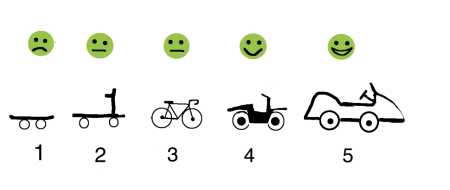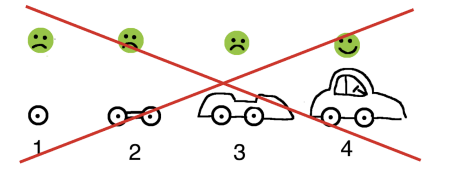Essentially, the MVP technique boils down to the idea of equipping a product with the minimum features required so it can be placed on the market as soon as possible. It is crucial that the customer is offered some benefit from the very outset. The example below illustrates how this works:
You are here:
The minimal viable product: a technique for achieving maximum agility
The minimum viable product (MVP) technique is one we frequently encounter when it comes to company agility and digitization. PostFinance’s own Dimitrios Ekatodramis, Solution Engineering Team Leader, and Fabian Probst, initiative leader for the digital transformation programme, explain what it’s all about.

Approaching your target step-by-step with an MVP
Rather than wait for a fully assembled car to be delivered, the customer is offered the solution of a skateboard – the first iteration of a product that meets the customer’s very basic requirements, i.e. getting from A to B. The product then undergoes more development across subsequent iterations, based on customer requirements. The result does not match the original solution envisaged, i.e. a car with a closed roof.

Time-to-market is becoming more important
The end product is continuously refined over the course of several iterations, and is tweaked and adapted to changing requirements, with the result that the customer eventually gets a convertible they are very happy with. So why is this technique so relevant? Customers don’t want to spend ages waiting for a solution. This is why having a short timespan between the idea and the product’s actual realization – the time-to-market – is so critical to its success.
Without an MVP, customer needs are ignored
But the MVP technique goes even further. Customer needs are incredibly diverse. If you decided right away to create a product offering a full range of features, you would potentially end up wasting time and money on features the customer does not really care about. In addition, a company must always try to generate the maximum customer benefit with the resources available. If a company uses the MVP technique across the board, it can generate greater customer benefit with the same amount of work.

Involve customers in product development
When you develop a new product or features, you start with a hypothesis. Approaches such as “design thinking” and “customer journeys” attempt to consider the customer perspective. The sooner you involve actual customers, the better. This way, customers can potentially be involved right from the development phase, or they can test the first prototype. Once the MVP is on the market, it is important to continuously measure the success of each of its features. This is the only way to ascertain where it would be worth refining a feature or perhaps even removing one. After all, a lean product is cheaper to maintain and generally easier to use.
The MVP notion at PostFinance
One project where PostFinance used the MVP technique was a project on the digitization and automation of procedures for customer address changes. All sorts of different factors made the project more complex, for instance, different channels for changes of address, moves within Switzerland or abroad, various customer groups and the partial automation of order processing and handling.
Less is more
It would have required an enormous amount of effort to include all of these aspects in the features of a comprehensive software package. Implementing every one of these aspects would also have resulted in a longer time-to-market. This is why each aspect was submitted to a utility analysis during the project. The deciding factors were implementation cost, degree of automation and degree of case coverage. The end result was an MVP that solely covered the online channel, private customers and moves within Switzerland. This MVP was fairly quick to implement, and could be done digitally. It proved highly beneficial, as it automates around 80% of all changes of address expected.
A win-win scenario
Thanks to the MVP technique, the project staff are able to focus on implementing a customer’s main requirements as fast as possible. Less urgent points or special cases are handled at a later date. And the customers also benefit from this approach. Continuous meaningful improvements and tweaks are viewed in a more positive light than complex changes.
